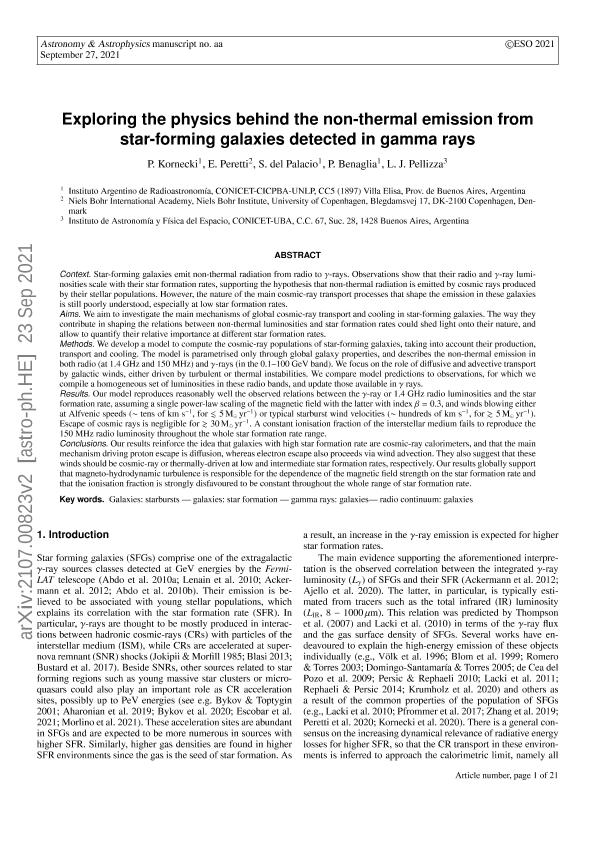Artículo
Exploring the physics behind the non-thermal emission from star-forming galaxies detected in γ rays
Kornecki, Paula ; Peretti, E.; del Palacio, Santiago
; Peretti, E.; del Palacio, Santiago ; Benaglia, Paula
; Benaglia, Paula ; Pellizza González, Leonardo Javier
; Pellizza González, Leonardo Javier
 ; Peretti, E.; del Palacio, Santiago
; Peretti, E.; del Palacio, Santiago ; Benaglia, Paula
; Benaglia, Paula ; Pellizza González, Leonardo Javier
; Pellizza González, Leonardo Javier
Fecha de publicación:
01/2022
Editorial:
EDP Sciences
Revista:
Astronomy and Astrophysics
ISSN:
0004-6361
Idioma:
Inglés
Tipo de recurso:
Artículo publicado
Clasificación temática:
Resumen
Context. Star-forming galaxies emit non-thermal radiation from radio to γ rays. Observations show that their radio and γ-ray luminosities scale with their star formation rates, supporting the hypothesis that non-thermal radiation is emitted by cosmic rays produced by their stellar populations. However, the nature of the main cosmic-ray transport processes that shape the emission in these galaxies is still poorly understood, especially at low star formation rates. Aims. Our aim is to investigate the main mechanisms of global cosmic-ray transport and cooling in star-forming galaxies. The way they contribute to shaping the relations between non-thermal luminosities and star formation rates could shed light onto their nature, and allow us to quantify their relative importance at different star formation rates. Methods. We developed a model to compute the cosmic-ray populations of star-forming galaxies, taking into account their production, transport, and cooling. The model is parametrised only through global galaxy properties, and describes the non-thermal emission in radio (at 1.4 GHz and 150 MHz) and γ rays (in the 0.1-100 GeV band). We focused on the role of diffusive and advective transport by galactic winds, either driven by turbulent or thermal instabilities. We compared model predictions to observations, for which we compiled a homogeneous set of luminosities in these radio bands, and updated those available in γ rays. Results. Our model reproduces reasonably well the observed relations between the γ-ray or 1.4 GHz radio luminosities and the star formation rate, assuming a single power-law scaling of the magnetic field (with index β = 0.3) and winds blowing either at Alfvenic speeds (∼tens of km s-1, for 5 Mpdbl yr-1) or typical starburst wind velocities (∼hundreds of km s-1, for 5 Mpdbl yr-1). Escape of cosmic rays is negligible for 30 Mpdbl yr-1. A constant ionisation fraction of the interstellar medium fails to reproduce the 150 MHz radio luminosity throughout the whole star formation rate range. Conclusions. Our results reinforce the idea that galaxies with high star formation rates are cosmic-ray calorimeters, and that the main mechanism driving proton escape is diffusion, whereas electron escape also proceeds via wind advection. They also suggest that these winds should be cosmic-ray or thermally driven at low and intermediate star formation rates, respectively. Our results globally support that magneto-hydrodynamic turbulence is responsible for the dependence of the magnetic field strength on the star formation rate and that the ionisation fraction is strongly disfavoured to be constant throughout the whole range of star formation rates.
Archivos asociados
Licencia
Identificadores
Colecciones
Articulos(IAFE)
Articulos de INST.DE ASTRONOMIA Y FISICA DEL ESPACIO(I)
Articulos de INST.DE ASTRONOMIA Y FISICA DEL ESPACIO(I)
Articulos(IAR)
Articulos de INST.ARG.DE RADIOASTRONOMIA (I)
Articulos de INST.ARG.DE RADIOASTRONOMIA (I)
Citación
Kornecki, Paula; Peretti, E.; del Palacio, Santiago; Benaglia, Paula; Pellizza González, Leonardo Javier; Exploring the physics behind the non-thermal emission from star-forming galaxies detected in γ rays; EDP Sciences; Astronomy and Astrophysics; 657; 1-2022; 1-21
Compartir
Altmétricas
Items relacionados
Mostrando titulos relacionados por título, autor y tema.
-
Artículo New quantitative nitrogen abundance estimations in a sample of Seyfert 2 active galactic nucleiDors Jr., O. L.; Arellano Córdova, K. Z.; Cardaci, Monica Viviana ; Hägele, Guillermo Federico (Wiley Blackwell Publishing, Inc, 2017-06)
-
Dors, Oli L.; Agarwal, B.; Hägele, Guillermo Federico ; Cardaci, Monica Viviana ; Rydberg, Claes Erik; Riffel, R. A.; Oliveira, A. S.; Krabbe, A. C. (Wiley Blackwell Publishing, Inc, 2018-09)
-
Carvalho, S.P.; Dors, O. L.; Cardaci, Monica Viviana ; Hägele, Guillermo Federico ; Krabbe, Nora Cristina; Pérez Montero, E.; Monteiro, A.F.; Armah, M.; Freitas Lemes, P. (Wiley Blackwell Publishing, Inc, 2020-06)



